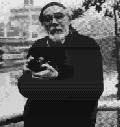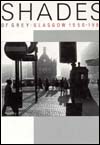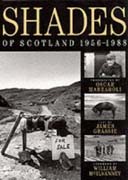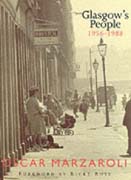photography
Shades of Grey
 William McIlvanney provides the foreword to this selection of photographs by Oscar Marzaroli, chosen with help from the Third Eye Centre from his file of 50,000 shots of the city taken over thirty years, now recognised as the most authentic visual record we have of Glasgow during this period of transformation. It is also the unsentimental record of a love affair between a man and a city. Whatever her dress, whatever her mood, Oscar Marzaroli loves Glasgow, warts and all.
William McIlvanney provides the foreword to this selection of photographs by Oscar Marzaroli, chosen with help from the Third Eye Centre from his file of 50,000 shots of the city taken over thirty years, now recognised as the most authentic visual record we have of Glasgow during this period of transformation. It is also the unsentimental record of a love affair between a man and a city. Whatever her dress, whatever her mood, Oscar Marzaroli loves Glasgow, warts and all.
Over the years he has worked the length and breadth of Scotland, with many of the foremost writers and artists of the day. The most adroit word-smith might find cause to envy the eloquence of his pictures.
I met Oscar in his new base in the Crawfurd Building of Jordanhill College of Education. He’s a big, gentle, bearded man who likes to call people ‘cats’. With a camera in his hand he’s a bit of a cat himself, a hunter with perfect pounce.
I wanted to find out how his reading (which I knew to be prodigious) might have set his mental focus. Or to put it another way…
Let’s try to trace possible connections and influences between reading and your photography.
There’s never a conscious relationship at the time I take a picture. Afterwards it’s possible to make connections. I can see Gogol’s Dead Souls in some pictures I’ve taken of alcoholics. If the shots had been contrived to match images from Gogol’s lower depths they would have had no spontaneity. They would have said something different.
In 1954 you had a very intense spell of reading when you were being treated for TB at the Grampian Sanatorium in Kingussie.
I was there for a year. The choice of reading was phenomenal. I read practically every book written by Tolstoy, Gorky, Dostoievsky – all the Russian greats. Then Rabelais, Voltaire, Camus. And Burns and Shakespeare.
After I left the sanatorium, I worked in Stockholm and London doing magazine features and fashion photography. Although it was a good way of earning a living it wasn’t really what I wanted to do. I wanted to take pictures of what was around me and influencing me. I found myself relating photographic images to images in literature. I was seeing bits of Tolstoy, Dostoievsky and Gorky in the streets. I had the inherent feeling that time was of the essence, that it wasn’t to be wasted, thrown away. With a stills camera, no matter what shape or size or whether it was cheap or expensive, I could always get some kind of immediate result.
 At a bookstall in Stockholm I bought a book of photographs published in 1955 by the Museum of Modern Art, New York; The Family of Man. Its 503 pictures speak for humanity at any time, through love and birth, work and play, pain and death. I’ve thumbed through it so often it’s falling apart.
At a bookstall in Stockholm I bought a book of photographs published in 1955 by the Museum of Modern Art, New York; The Family of Man. Its 503 pictures speak for humanity at any time, through love and birth, work and play, pain and death. I’ve thumbed through it so often it’s falling apart.
When I got back to Glasgow in 1959 the city was changing and I wanted to get it in the can. The changes were being expressed in the poems of Edwin Morgan, the paintings of Joan Eardley and Angus Neil, the songs of Adam McNaughtan about throwing jeely pieces out of a thirty storey new high flat. Gorbals, Hutchesontown, Cowcaddens, Anderson and many other areas had been made Development areas. I felt a need to establish a rapport with the city and its people. A place like the Gorbals was a microcosm of what was happening in all the great cities of the world. It was as exciting as any location could have been. It’s possible that in my choice of subject I was being influenced by Gorky or Burns, writers who were near to the people. But I wasn’t conscious of it at the time. There was no question of me going out to look for what was considered then the tougher element of the city, or for something topical. All I know is I had a need to get down there daily, weekly, monthly with a camera. The city in general but Gorbals and Hutchesontown in particular. Some people aren’t happy with my pictures of Glasgow. They’re not rosy pictures in beautiful Technicolour. They’re black and white and they are what they are, a happening in time which was quite authentic. To this day I get letters from the people of the Gorbals and I go along to their community happenings and take pictures. But going back and attempting to physically reinterpret the Fifties/early-Sixties period is impossible. With the high flats that replaced tenements the streets look comparatively devoid of life. No Johnny Walker or Black and White Label carts going along with barrels of whiskey, no coal carts with horses, no rag-and-bone man blowing his trumpet in the street, no kiddies jumping up with joy at a balloon they got for a bundle of rags.
They’re in watching moving pictures on the television.
Exactly. Many people are inside watching pictures on the television. Or they’re at the cinema. Or who knows, they’re at the Burroo, as they say, looking for employ.
One of my shots shows one of the last Gorbals tenements smoking in the foreground and the sun going down between the new buildings going up. The reawakening of the city. To say there’s not an improvement would be a mistake. The old tenements were decrepit, there were no inside toilets, and I’ve stumbled over more than one rat going up a close. That doesn’t happen now. But it’s bad in other ways. No Loitering. No Ball Games. No Fun. Anyway, I still feel obligated to go back looking for some kind of change.
Annan’s wonderful pictures of Glasgow’s old wynds and closes of a hundred years before were tailored to the needs of the City Fathers of that time. Bert Hardy did an assignment on Glasgow for Picture Post. I feel something of myself in him. The photo-journalist, wanting to get in there. There was too much of the poet in that great hero of mine Bill Brandt; he came on an assignment to take pictures around the Gorbals and failed totally because his kind of photography was such that he saw and felt something in the area that wasn’t in tune with him. I had no commissions to take pictures of Glasgow. Between doing paid work I’d be down shooting the city. I’m still doing it.
 Right now, with help from the Third Eye Centre in Glasgow, I’m making a selection of 320 photographs from the 50,000 shots I have for a book on Glasgow 1957-1987. A personal view. It will be published this Christmas by Mainstream with a foreword by William McIllvanney. It’s a labour of love. Technically I’ve been working on it for thirty years.
Right now, with help from the Third Eye Centre in Glasgow, I’m making a selection of 320 photographs from the 50,000 shots I have for a book on Glasgow 1957-1987. A personal view. It will be published this Christmas by Mainstream with a foreword by William McIllvanney. It’s a labour of love. Technically I’ve been working on it for thirty years.
Have you any comments on photographs as book illustration?
Within the book, interspersing snaps all over the place doesn’t work. It can work quite nicely with lithography or free hand drawing. But photographs must stand separately from the text.
There’s an affinity between your pictures and Joan Eardley’s paintings of Glasgow.
If you’re asking me if she had an influence on my picture taking, yes, Joan Eardley more than anyone. Her work has an immediate quality, a realism, and a kind of urgency. Here in her paintings were the children of the tenements as I recall them from my own childhood in Garnethill, which was a very mixed area; Hungarians, Italians, Irish, Polish, Lithuanian. And the ladies going to the steamie, hanging the washing out of the window. It made a fair mark on me.
Changing tack now. You’ve photographed many Scottish writers.
A lot of that was done alongside film work. Compton MacKenzie, Sorley McLean, Ian Crighton Smith, Sydney Goodsir Smith… a lot of these pictures are now being exhibited or they’re finding their way into books, but they weren’t commissioned either. They were often taken in relaxed moments between filming. The making of a film, no matter how small, is a very hard piece of technical expertise and a great sweat not only for the people behind the camera but for those in front. The best time to freeze a few images was in moments of respite when the writers were very much themselves and not all tensed up in front of a movie camera. And when you got a man of the calibre of Norman MacCaig with a man of the calibre of Hugh MacDiarmid sparks would surely fly. They would still go on talking with the same ferocity and conviction even after the camera had stopped turning. So a stills camera was the natural thing to pick out of the bag. With the stills camera you can get moments of joy or aggressiveness between two people, but you can’t get the marvellous eloquence of word.
Did photographing writers lead you on to reading their books?
That happened. You’re looking at a picture as you’re printing it and you’re saying, ‘This man, this Christopher Grieve, this Hugh MacDiarmid, what makes him tick? Why is he such a wonderful man?’ I made a film on him, Hugh MacDiarmid. No Fellow Travellers. If I hadn’t had the chance to do film work on him, would I have been brave enough to approach him? Knowing the man as I did after three visits, I realise that his door would always have been open. That if I had chapped and said, ‘Look, I’m a snapper in from the cold, can you give me a cup of tea?’ his wife and himself would have made me welcome with a dram and a pipe of tobacco and I would have been snapping before the hour was out.
You’ve also worked closely with writers in making films, and had a particularly fruitful relationship with Allan Campbell McLean.
During the Seventies we worked together on six or seven documentaries about the Highlands from Shetland to Tiree. We went to Out Skerries, a community of 80 people; they were more Scandinavian than Scot and their speech was so guttural I could hardly understand them. But Allan has a marvellous gift; whoever he talks to, whether a crofter from the Out Skerries or a salmon fisherman from Skye, he puts them at their ease and draws out the best in them. I found our collaboration very exciting. He fired my imagination. For example, his description of the steps at Whaligoe in Caithness for Explore the Highlands and Islands brought the past right into the present for me; going down these steps I felt I might meet one of the locals on the way up laden with chunks of whale blubber or whatever. Because of being with Allan, I read everything he had written and could relate to it all particularly strongly. I could tune in to what he was about.
One of his major pieces of work, The Glasshouse, stands outside the realm that he’s mostly known for. It’s a novel based on his experiences in the army during the Second World War. It gave him nothing but trouble at the time. They wouldn’t publish in America for many years because of a few four letter words, and he being the man he is would not change these words. Perhaps because of all this, his work developed in another direction. Although The Glasshouse was a failure in terms of publishing, it was a great success in terms of literature. It should be made into a film.
Have you ever had to make compromises in your work?
 Yes. I must do commercial work by way of survival material. We all have to make compromises to make a living. I’m sure this was the case for many writers – certainly Hemingway had to do it when he worked journalistically, James Joyce had to teach, H.G. Wells and Bernard Shaw had to do other jobs to make a living. Hugh MacDiarmid in his early days in journalism no doubt aspired to greater things but decided that was his time to make his compromise.
Yes. I must do commercial work by way of survival material. We all have to make compromises to make a living. I’m sure this was the case for many writers – certainly Hemingway had to do it when he worked journalistically, James Joyce had to teach, H.G. Wells and Bernard Shaw had to do other jobs to make a living. Hugh MacDiarmid in his early days in journalism no doubt aspired to greater things but decided that was his time to make his compromise.
In terms of my own work, it’s time for me to stop making movies and stop making compromises and do something for me again. The stills camera means I do my own thing. With one picture you can get what it takes a whole film to do, without all the paraphernalia.
For film you have to rearrange things to some extent, even just the activity of film making makes you unsure how you might be affecting things. With the stills camera hanging round your neck or dangling from your arm it’s taken for granted, it’s just a wee toy. In fact it’s anything but. It’s a very powerful weapon. You wait for your golden moment, quickly bring it to the eye, take that snap and put it down before anyone can say, ‘What’s happened here?’
Glasgow’s People 1956-1988 (£14.99 HBK, ISBN 1851585923) and Shades of Scotland 1956-1988 (£4.99 PBK, ISBN 1851582134) are available from Mainstream Publishing.
Copyright Jennie Renton 1986

Comments